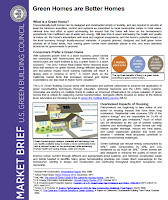 Jeremy Sigmon, LEED® AP BD+C
Jeremy Sigmon, LEED® AP BD+C
Director, Technical Policy
U.S. Green Building Council
Even in a still struggling economy, green building policymaking continues. To celebrate some of the impressive progress this year, USGBC partnered with the National Caucus of Environmental Legislators (NCEL) to convene key state lawmakers in Chicago this past Tuesday during the annual meeting of the National Conference of State Legislatures (NCSL). The most notable successes to date have been in the proliferation of green schools policymaking – more than 80 bills in 28 states this year alone.
Big buildings – like schools, office buildings and civic structures – capture a lot of the limelight in green building policy and practice. Rightfully so, you might say, due to their typically large social, economic and environmental footprint. But in a nation with more than 130 million homes and growing, the numbers point to a similarly important opportunity for residential buildings to make important contributions to a more sustainable future.
 |
|
| Access the policy brief. |
At Tuesday’s event, the group of leading state policymakers explored how government could help augment the potential of residential buildings to contribute to achieving sustainability goals. We introduced a new policy brief to answer that question: Green Homes are Better Homes.
To date, USGBC counts more than 400 public policy initiatives that promote or advance green building and LEED. Only 25 of these, however, make a concerted effort to leverage all that a green home can contribute to a greener neighborhood or community. (If I’m missing one you know about, please do send it in!) New Mexico and Cincinnati have probably had some of the most celebrated successes with their programs, and New York State Governor Andrew Cuomo just approved a bill last month that would allow New York municipalities to offer similar, powerful incentives.
Of course, Adam Smith would argue that the Invisible Hand of the free market, too, has a critical role to play. But efficient and transparent systems for sellers and buyers of green homes aren’t yet widely available. We’ve got a campaign for that: Highlight Green Homes. And while the market may eventually provide adequate and appropriate housing for all, healthy and efficient affordable housing is needed today. We’ve got a campaign for that, too: Value Healthy and Efficient Affordable Housing. And to accelerate the market uptake of green homebuilding practices, our Leadership with LEED campaign promotes incentives for building green homes that are verified and tested by a third-party, like a LEED for Homes Green Rater.
At Tuesday’s gathering, Jason La Fleur, Regional Director of the Alliance for Environmental Sustainability and lead residential advocate for USGBC-Illinois, provided lawmakers with his professional perspective from the field. “Green homes address many of the energy and environmental issues that state legislators are already focusing on, such as energy efficiency, water efficiency, resource conservation, reduced toxicity, stormwater management, heat island reduction and more.”
In addition to providing incentives for market uptake of green homebuilding practice, some states are demanding higher energy and environmental performance of their new and existing affordable housing stock. Helping the market operate more efficiently may be the most transformative means to unleash the potential of green homes and, as La Fleur said, “It’s all about allowing the market to quantify the value of green.” At the federal level, help is hopefully on the way with the SAVE Act.
In the California marketplace, where green homebuilding has been prolific and is now also required in the statewide code, we now have empirical evidence that green homes sell for a premium – upwards of nine percent according to a study released last month. La Fleur added that some projects in Chicago report 20 percent value premiums for LEED certified homes. Higher valuation creates a greater asset value for homeowners, establishes a broader tax assessment base for municipal governments, and drives the market to deliver more green real estate.
June’s announcement of 20,000 LEED-certified homes and the accelerating growth of the program does provide promise that the residential marketplace is expanding, but there is a lot of ground to gain. How will you help policymakers incentivize the sustainability potential of 130+ million homes?

Leave a Reply
You must be logged in to post a comment.